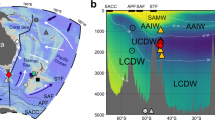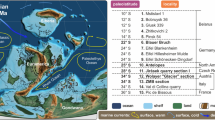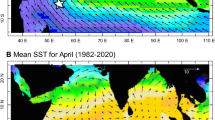Abstract
During the Younger Dryas event, about 12,000 years ago, the Northern Hemisphere cooled by between 2 and 10 °C (refs 1, 2) whereas East Antarctica experienced warming3. But the spatial signature of the event in the southern mid-latitudes and tropics is less well known, as records are sparse and inconclusive4,5,6,7,8,9,10,11,12,13,14,15,16. Here we present high-resolution analyses of skeletal Sr/Ca and 18O/16O ratios for a giant fossil Diploastrea heliopora coral that was preserved in growth position on the raised reef terraces of Espiritu Santo Island, Vanuatu, in the southwestern tropical Pacific Ocean17. Our data indicate that sea surface temperatures in Vanuatu were on average 4.5 ± 1.3 °C cooler during the Younger Dryas event than today, with a significant interdecadal modulation. The amplified annual cycle of sea surface temperatures, relative to today, indicates that cooling was caused by the compression of tropical waters towards the Equator. The positive correlation in our record between the oxygen isotope ratios of sea water and sea surface temperatures suggests that the South Pacific convergence zone, which brings 18O-depleted precipitation to the area today, was not active during the Younger Dryas period.
This is a preview of subscription content, access via your institution
Access options
Subscribe to this journal
Receive 51 print issues and online access
$199.00 per year
only $3.90 per issue
Buy this article
- Purchase on Springer Link
- Instant access to full article PDF
Prices may be subject to local taxes which are calculated during checkout



Similar content being viewed by others
References
Peteet, D. Global Younger Dryas? Quat. Int. 28, 93–104 (1995)
Anderson, D. Younger Dryas research and its implications for understanding abrupt climatic change. Prog. Phys. Geogr. 21, 230–249 (1997)
Watanabe, O. et al. Homogeneous climate variability across East Antarctica over the past three glacial cycles. Nature 422, 509–512 (2003)
Bennett, K. D., Haberle, S. G. & Lumley, S. H. The last Glacial-Holocene transition in southern Chile. Science 290, 325–328 (2000)
Singer, C., Shulmeister, J. & McLea, B. Evidence against a significant Younger Dryas cooling event in New Zealand. Science 281, 812–814 (1998)
Rodbell, D. T. & Seltzer, G. O. Rapid ice margin fluctuations during the Younger Dryas in the Tropical Andes. Quat. Res. 54, 328–338 (2000)
Thompson, L. G. Ice core evidence for climate change in the tropics: implications for our future. Quat. Sci. Rev. 19, 19–35 (2000)
Guilderson, T. P., Fairbanks, R. G. & Rubenstone, J. L. Tropical Atlantic coral oxygen isotopes: glacial-interglacial sea surface temperatures and climate change. Mar. Geol. 172, 75–89 (2001)
Ruhlemann, C., Mulitza, S., Muller, P. J., Wefer, G. & Zahn, R. Warming of the tropical Atlantic Ocean and slowdown of thermohaline circulation during the last deglaciation. Nature 402, 511–514 (1999)
Koutavas, A., Lynch-Stieglitz, J., Marchitto, T. M. & Sachs, J. P. El Niño-like pattern in ice age tropical Pacific sea surface temperature. Science 297, 226–230 (2002)
Kienast, M., Steinke, S., Stattegger, K. & Calvert, S. E. Synchronous tropical south China sea SST change and Greenland warming during deglaciation. Science 291, 2132–2134 (2001)
Thunell, R. C. & Miao, Q. Sea surface temperature of the western equatorial Pacific Ocean during the Younger Dryas. Quat. Res. 46, 72–77 (1996)
Stott, L., Poulsen, C., Lund, S. & Thunell, R. Super ENSO and global climate oscillations at millennial time scales. Science 297, 222–226 (2002)
Beck, J. W. et al. Sea-surface temperature from coral skeletal strontium/calcium ratios. Science 257, 644–647 (1992)
Patrick, A. & Thunell, R. C. Tropical Pacific sea surface temperatures and upper water column thermal structure during the last glacial maximum. Paleoceanography 12, 649–657 (1997)
Andres, M. S., Bernasconi, S. M., McKenzie, J. A. & Röhl, U. Southern Ocean deglacial record supports global Younger Dryas. Earth Planet. Sci. Lett. 216, 515–524 (2003)
Cabioch, G. et al. in Reefs and Carbonate Platforms in the Pacific and Indian Oceans (eds Camoin, G. & Davies, P. J.) 261–277 (IAS Special Publication Vol. 25, International Association of Sedimentologists, Blackwell, Oxford, 1998)
Burr, G. S. et al. A high resolution radiocarbon calibration between 11,700 and 12,400 calendar years BP derived from 230Th ages of corals from Espiritu Santo Island, Vanuatu. Radiocarbon 40, 1093–1105 (1998)
Watanabe, T., Gagan, M. K., Corrège, T., Scott-Gagan, H. & Hantoro, W. S. Oxygen isotopes systematics in Diploastrea heliopora: New coral archive of tropical paleoclimate. Geochim. Cosmochim. Acta 67, 1349–1358 (2003)
McConnaughey, T. 13C and 18O isotopic disequilibrium in biological carbonates: I. Patterns. Geochim. Cosmochim. Acta 53, 151–162 (1989)
Gagan, M. K., Chivas, A. R. & Isdale, P. J. High-resolution isotopic records from corals using ocean temperature and mass-spawning chronometers. Earth Planet. Sci. Lett. 121, 549–558 (1994)
Stoll, H. M. & Schrag, D. P. Effects of Quaternary sea level cycles on strontium in seawater. Geochim. Cosmochim. Acta 62, 1107–1118 (1998)
Fairbanks, R. G. A 17,000-year glacio-eustatic sea level record: Influence of glacial melting rates on the Younger Dryas event and deep-ocean circulation. Nature 342, 637–642 (1989)
Gagan, M. K. et al. Temperature and surface-ocean water balance of the mid-Holocene tropical western Pacific. Science 279, 1014–1018 (1998)
Ren, L., Linsley, B. K., Wellington, G. M., Schrag, D. P. & Hoegh-Guldberg, O. Deconvolving the δ18O seawater component from subseasonal coral δ18O and Sr/Ca at Rarotonga in the southwestern subtropical Pacific for the period 1726 to 1997. Geochim. Cosmochim. Acta 67, 1609–1621 (2003)
Delcroix, T. & Hénin, C. Mechanisms of subsurface thermal structure and sea surface thermohaline variabilities in the southwestern tropical Pacific during 1979–85. J. Mar. Res. 47, 777–812 (1989)
Corrège, T. et al. Evidence for stronger El Niño Southern Oscillation (ENSO) events in a mid-Holocene massive coral. Paleoceanography 15, 465–470 (2000)
Schmidt, G. A. Error analysis of paleosalinity calculations. Paleoceanography 14, 422–429 (1999)
An, S. I. & Wang, B. Interdecadal change of the structure of the ENSO mode and its impact on the ENSO frequency. J. Clim. 13, 2044–2055 (2000)
Karspeck, A. R. & Cane, M. A. Tropical Pacific 1976–77 climate shift in a linear, wind-driven model. J. Phys. Oceanogr. 32, 2350–2360 (2002)
Acknowledgements
We thank A. Ganachaud and the participants of the ‘International workshop on the low frequency modulation of ENSO’ (Toulouse, September 2003) for discussions and comments; H. Scott-Gagan for help with the isotopic measurements; Y. Join, J. L. Laurent, M. Lardy, F. Taylor and J. Récy for providing assistance in the field; the government of Vanuatu for allowing us to drill in Espiritu Santo; and B. Suwargadi, S. Fallon, D. Whitford, G. Whitford and the Indonesian Institute of Sciences (LIPI) for support with coral drilling in Alor, Indonesia. The IRD, ANU and NSF supported this work.
Author information
Authors and Affiliations
Corresponding author
Ethics declarations
Competing interests
The authors declare that they have no competing financial interests.
Additional information
Coral data presented here are available at http://www.ngdc.noaa.gov/paleo/coral/vanuatu.html.
Supplementary information
Supplementary Information
Contains supplementary information on method and error calculations, supplementary references, and the legend for the two supplementary figures. (DOC 23 kb)
Supplementary Figure 1
Shows time series of Sr/Ca versus SST for modern Diploastrea specimens from New Caledonia and Indonesia. These data are used in figure1 to calculate the Sr/Ca vs SST regression. (DOC 40 kb)
Supplementary Figure 2
Shows time series of Sr/Ca versus SST for modern Porites specimens from New Caledonia and Indonesia. These data are used in figure1 to calculate the Sr/Ca vs SST regression. (DOC 38 kb)
Rights and permissions
About this article
Cite this article
Corrège, T., Gagan, M., Beck, J. et al. Interdecadal variation in the extent of South Pacific tropical waters during the Younger Dryas event. Nature 428, 927–929 (2004). https://doi.org/10.1038/nature02506
Received:
Accepted:
Issue Date:
DOI: https://doi.org/10.1038/nature02506
This article is cited by
-
Understanding cold bias: Variable response of skeletal Sr/Ca to seawater pCO2 in acclimated massive Porites corals
Scientific Reports (2016)
-
The Coral Trait Database, a curated database of trait information for coral species from the global oceans
Scientific Data (2016)
-
Intensification of the meridional temperature gradient in the Great Barrier Reef following the Last Glacial Maximum
Nature Communications (2014)
-
Effect of salinity on the skeletal chemistry of cultured scleractinian zooxanthellate corals: Cd/Ca ratio as a potential proxy for salinity reconstruction
Coral Reefs (2014)
-
Past daily light cycle recorded in the strontium/calcium ratios of giant clam shells
Nature Communications (2012)
Comments
By submitting a comment you agree to abide by our Terms and Community Guidelines. If you find something abusive or that does not comply with our terms or guidelines please flag it as inappropriate.



